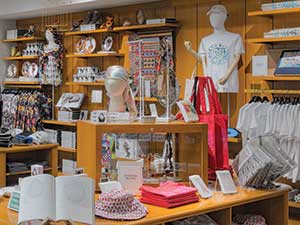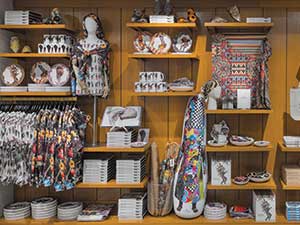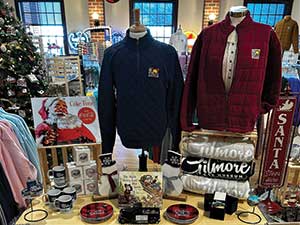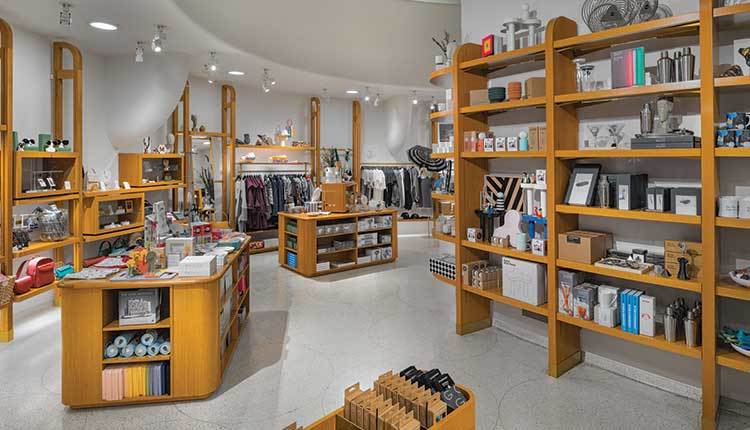Museum gift shops are enjoying a resurgence in book sales among other popular keepsakes that relate to each venue’s unique collections.
For museum gift shops, it’s likely a no-brainer that the bestselling souvenir relates to the content covered by the exhibits within a collection. Whether it’s a passion for art, dinosaurs, cars, history or sports, those who visit want to take home a sliver of the cherished subject matter.
Most recently, there is a new favorite among the bunch. Actually, it’s an old favorite with a renewed resurgence for turning heads as well as pages. Books are pushing their way to the forefront as popular method of sharing one’s love for a particular topic.
“I think anybody in any kind of retail industry, especially museums and booksellers, saw a huge drop off [in books] about 10 years ago,” says Kristin Rae, general manager of retail for the Guggenheim Museum Store in New York. “But it’s been inching back, and I feel like more people are gifting books more.”
Known for its collection of modern and contemporary art as well as the Solomon R. Guggenheim Museum building being an architectural icon itself, the collection of books in the museum store spans the careers of Pablo Picasso and Frank Lloyd Wright while also covering photography and poetry.
 The Guggenheim Museum Store's affiliation with modern and contemporary art is reflected in the merchandise it carries. Also of note, Rae points out, is an interest in young-adult-directed materials and people sharing art books with children.
“We even brought in the Little Golden Book of Frida Kahlo and we can’t keep it in stock,” she asserts.
“People are definitely reconnecting and introducing their children to art books, and that’s been really neat to see — and more so this past year than ever before that I’ve noticed.”
At the Oklahoma History Center Museum where the exhibits cover history from before statehood to present, Museum Store Supervisor Lacey McMillan agrees books play a vital role in the gift shop, accounting for half of the inventory within the 500-square-foot space.
In particular, she adds, “Killers of the Flower Moon” by David Grann is taking the shop by storm.
“I sold through it faster than any product I’ve sold through,” she notes. “Because the movie just came out and with it being local to Oklahoma and a true story and everything.”
Among kid’s books that are selling well, McMillan points to “Will Rogers and the Great White House Sleepover” by Bart Taylor as being a favorite. The author is a two-time Oklahoma Museum Association Award-winning educator from Tulsa, Oklahoma. He has worked as an educator at Will Rogers Memorial Museum, among others, according to a book review on Amazon.
Selling a mystery Besides books, McMillan points to another top-seller for children. “As funny as it seems, our No. 1 kids’ seller are these little mystery bags that we make,” she says with a laugh. “They cost less than $3 and the kids lose their minds over them, and they always get them.”
The prized goody bags are filled with bulk toys, such as Slinkys, bandanas and plastic pistols, McMillan notes.
 The Guggenheim Museum Store's affiliation with modern and contemporary art is reflected in the merchandise it carries. “Each one is a little different and the kids can’t quite feel what it is,” she says. “I always tell them I don’t even know what’s in it, and they love it.”
She adds the museum hosts a lot of field trips and she believes their popularity comes down to simple economics in the mind of a child.
“I think it’s the fact that they can get multiple items for a reasonable price,” she notes. “Because usually whenever we have field trips, kids will get maybe a $5 bill or maybe a $20 bill [for a souvenir], and that’s all they have and they want to get as much as they can for their money.”
For this reason, McMillan says the store is sure to have no fewer than 20 mystery bags on hand at all times.
Pint-sized is preferredChildren aren’t the only guests drifting to smaller, more portable treasures. At the Gillmore Car Museum in Hickory Corners, Michigan, Assistant Manager, Esther Ordway, says it seems as though the smaller the better these days. And nothing pinpoints a destination more simply than a postcard — one of the more popular souvenirs in the museum “dedicated to preserving the history and heritage of the American automobile,” according to the nonprofit organization’s website.
Among the other popular items at the gift shop are full cloth hats as opposed to mesh-back ball caps, and personalized license plate keychains by ScandiCal.
Ordway notes the 65-plus mostly male demographic the museum tends to attract makes for a tough sale in the gift shop for more than one reason. For starters, men typically don’t like to shop, according to her.
“A lot of times, we have to step back and think, ‘is this something we like in our generation or is this something that’s going to appeal to our demographic,’ which is very often an older individual,” she explains. “So, looking at it with a different set of eyes than our own opinion is probably our biggest struggle.”
And when it comes to pinning down that perfect memento, Ordway notes, it comes down key attributes.
“Things made in the USA, anything made here they really like,” she says. “And anything smaller that says ‘hey, I was here,’ that’s what we get most often.”
And there’s probably no easier way to spell out “I was here” quite like a name drop, notes Rich Caplan, vice president of sales for Little Critterz Inc. and Animals Forever Inc.
“Name drop and other customization is very important to tie a product to the museum experience,” Caplan says. “We see a big trend toward realism in museum gift shop merchandise, especially items that people connect emotionally with.”
Little Critterz Inc. and Animals Forever Inc. have curated a world of animal- and nature-themed products; Caplan points to the company’s handmade miniature porcelain figurines, snow globes, iron-on patches and “floaty pens” as doing best in museum gift shops.
Dialing in the displaysAnd when it comes to the best displays, Caplan says, getting it right out of the gate makes a difference in return on investment.
 Merchandise at The Gillmore Car Museum is curated to appeal to men over 65. For this reason, he points to warm wood fixtures, themed areas, well-stocked and organized displays and good lighting as key ingredients in showing off the best a museum has to offer.
For children, Caplan points to cross merchandising for success.
“Quite often kids start a collection with a purchase in the shop, and then want more,” he notes. “Many shops benefit from having the same products also available on their web stores.”
When it comes to the much-coveted book collections, McMillan suggests front-facing, accessible displays.
Fortunately, the recent success of “Killers of the Flower Moon” on the big screen and a small exhibit at the museum made it ideal for a front-facing table with the young-adult-adapted version and the original version.
Additional copies found a home on a wall with multiple face-outs.
“Having them face out and having them where people feel comfortable grabbing them is usually a safe bet,” she says.
Front facing and up on walls doesn’t just work for books.
When it comes to apparel, people not only want to be able to read the name drop, but they also want to see the imagery, graphics — or ears and tails — on the garment. Such is the case for Doodle Pants, whose leggings and 3D hoodies align with messages of wildlife protection and natural-resource conservation.
Taly Eddington, who dubs herself the Office Gnome at Doodle Pants, says the popularity of a design typically depends on the type of museum. For example, the Spiky Dino is ideal for museums with dinosaur specimens while the space collection works well in planetariums. However, she says some of their bestsellers will cross many genres, such as bees, butterflies, sea turtles and most recently — alligators.
“My biggest recommendation for museums … is to take advantage of a name-dropping service,” she recommends. “It really does make a huge difference in the amount of products that sell.”
At the Guggenheim Museum Store, Rae says no matter which souvenirs museums embrace, it’s a matter of drilling down what is at the heart of a museum’s collection and delivering a meaningful brand to adoring followers.
“I think it’s finding your core and really investing in it,” she says. “You need to find your identity and build out that core, but also find ways to keep it fresh and not stagnate.”
|




